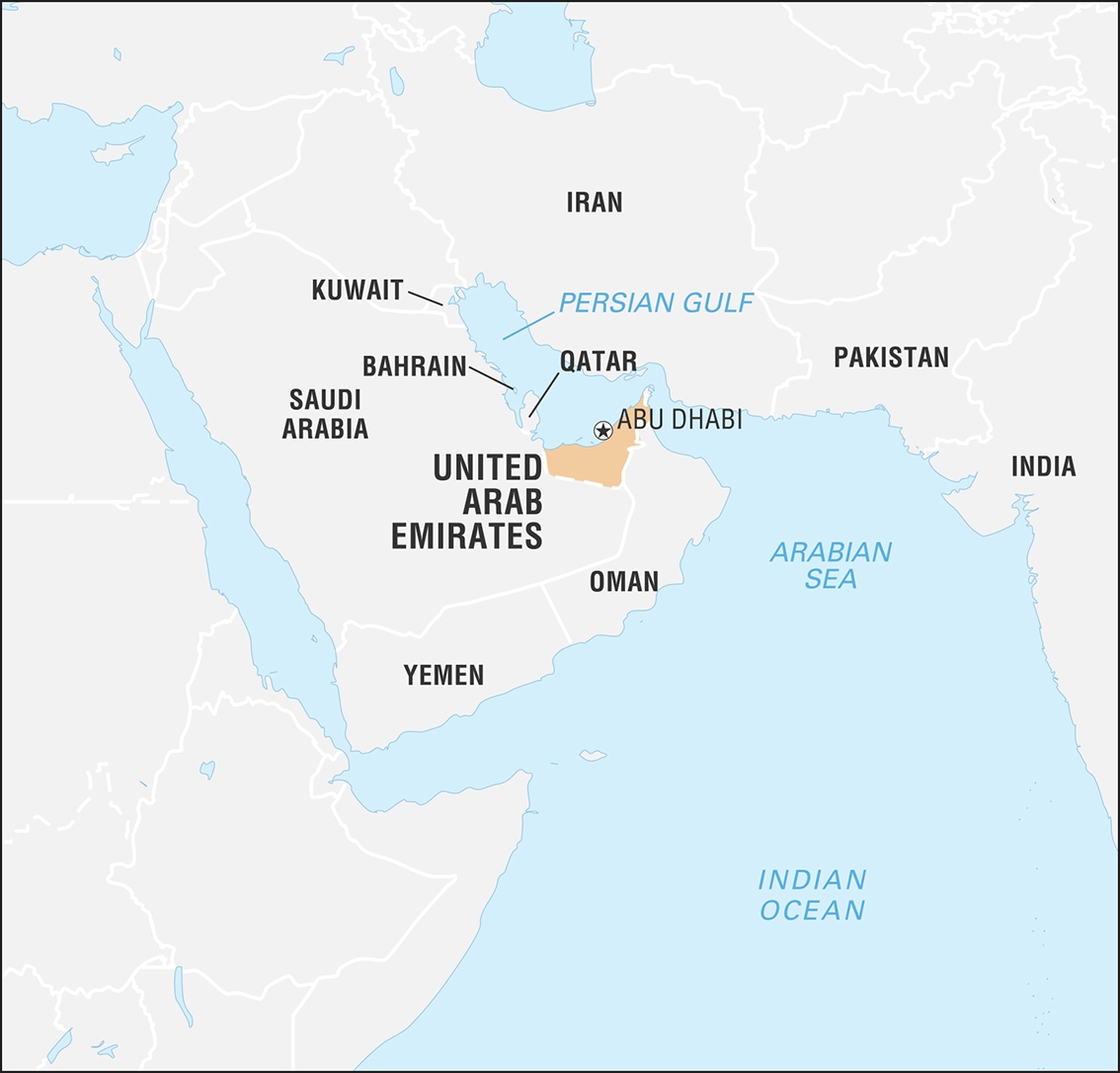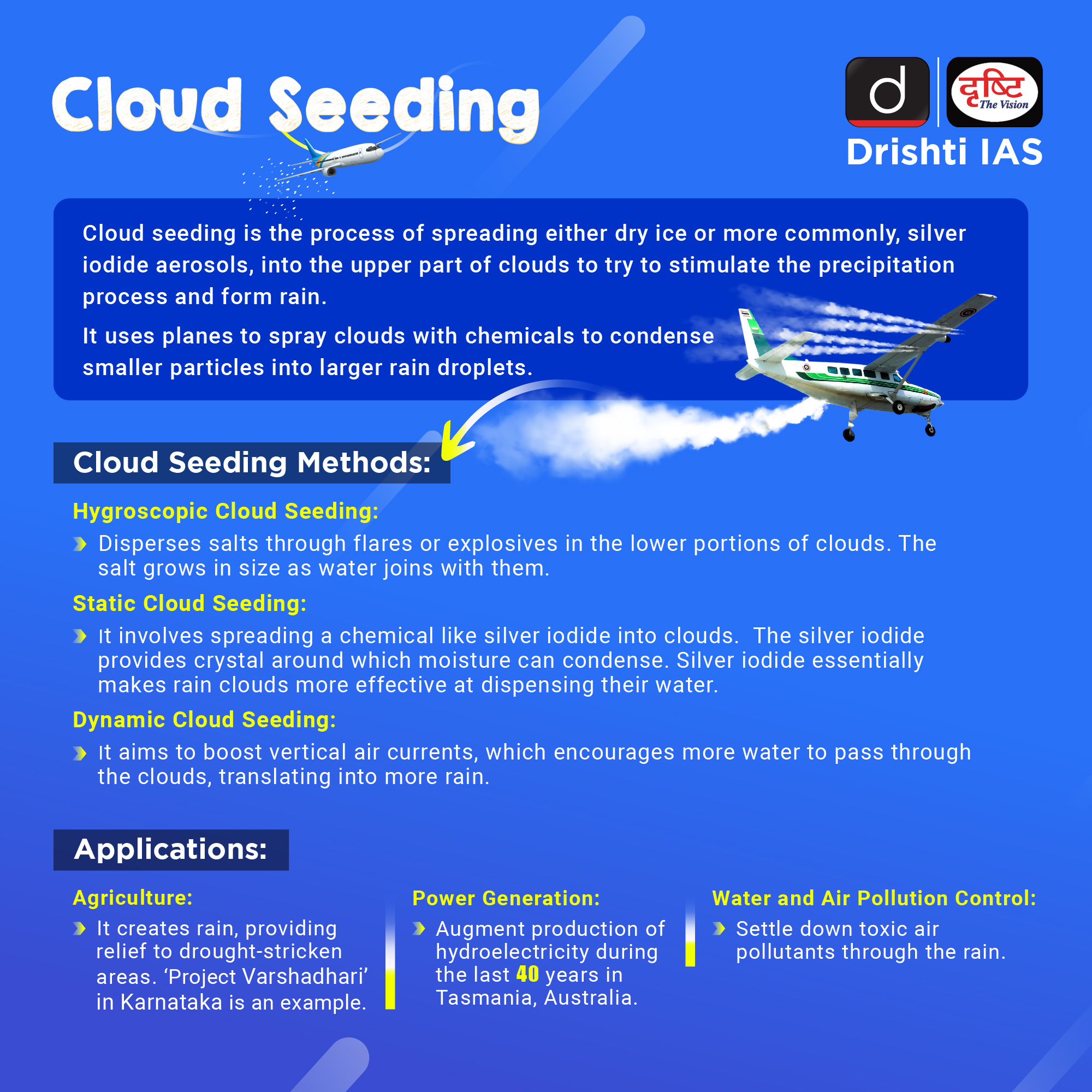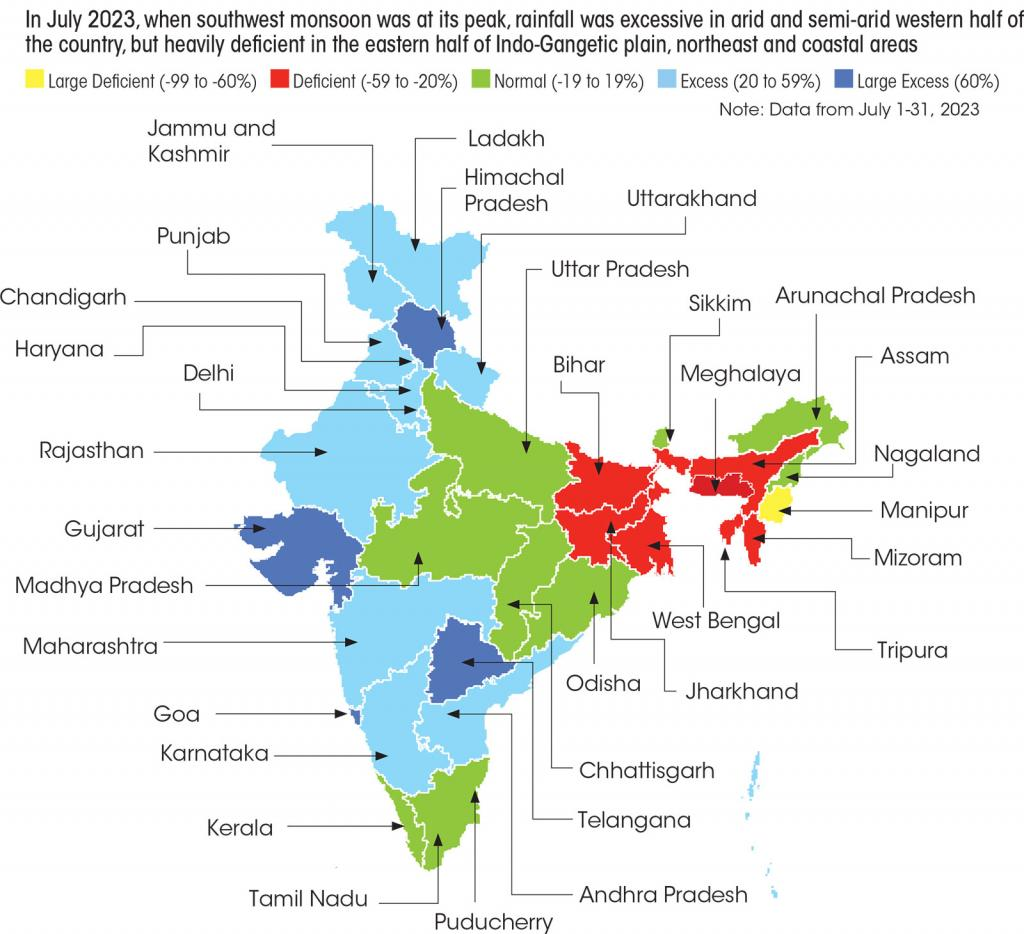Geography
Massive Floods in Dubai
- 25 Apr 2024
- 12 min read
For Prelims: Rainfall, Drainage System, Climate Change, Cyclones, Tornados.
For Mains: Impacts of Climate Change in India and World, Disaster Resilient Infrastructure, Clean Energy.
Why in News?
Recently, one of the heaviest rainfall was recorded in the United Arab Emirates (UAE), after a severe thunderstorm hit the country. The storm had initially hit Oman before it landed in the UAE.
- On the other hand, Mumbai, lying on the other side of the Arabian Sea, has been undergoing a humid heatwave for the past few days, having a high relative humidity of 55%.
What is the reason for Mumbai’s Hot Weather?
- The reason for Mumbai’s hot weather is a huge Anti-Cyclonic Effect developed in the region.
- Anticyclones are areas of high atmospheric pressure.
- Winds in anticyclones move downward and compress, causing heating. They often lead to large-scale heatwaves.
- Anticyclones can block other weather systems, causing extreme conditions around them.
- In Mumbai, the anticyclone caused a “heat dome” effect, warming the air further.
- Warm air from West Asia and the Arabian Sea was drawn in and heated by sinking motion. This increased humidity in Mumbai, especially before the monsoon season.
- Normally, sea breezes cool Mumbai at night, but the anticyclone may have blocked them. As a result, night temperatures were higher than usual.
What is the Climate of United Arab Emirates (UAE) and Rain Pattern?
- About:
- UAE lies in the arid regions of the world, so such heavy rainfalls are unusual there.
- On average, Dubai experiences 94.7 mm of rain in a year. But this event was historic as it brought more than 142 mm of rainfall that had soaked Dubai over 24 hours.
- Possible Causes of Extreme Rain: The possible causes for such catastrophic event may be attributed to following reasons.
- Climate Change:
- Climate Change along with multiple factors associated with it like patterns of natural climate variability, such as El Niño and La Niña, has contributed to the extreme rain.
- Global warming: It has led to higher temperatures causing evaporation of water not only from land but also oceans and other water bodies, causing a warmer atmosphere to hold more moisture.
- For every 1 degree Celsius rise in average temperature, the atmosphere can hold about 7% more moisture.
- This makes storms more dangerous as it leads to an increase in precipitation intensity, duration and/or frequency of storm.
- Cloud Seeding:
- Cloud seeding is a process in which chemicals such as silver iodide crystals are implanted into clouds to increase rainfall in an environment where water scarcity is a concern.
- UAE, located in one of the hottest and driest regions on earth, has been leading the effort to seed clouds and increase precipitation.
- Thunderstorm:
- Thunderstorms are generated by atmospheric imbalance and turbulence caused by a combination of several conditions, including unstable, warm air rising rapidly into the atmosphere; sufficient moisture to form clouds and rain; and upward lift of air currents caused by colliding weather fronts (cold and warm), sea breezes, or mountains.
- Climate Change:
What are Thunderstorms?
- About:
- It is also known as an electrical storm or a lightning storm, is a storm in which lightning strikes and produces a tremendous audible effect in the Earth's atmosphere.
- It often occurs in warm, humid environments and can bring about intense rainfall, hail, and powerful winds. These storms usually develop in the afternoon or evening and can persist for a few minutes to several hours.
- Formation: There are 3 stages in the formation of a thunderstorm.
- Cumulus stage:
- The ground is greatly heated due to solar insolation.
- Due to the intense lifting of an air parcel, a low pressure begins to form (convention).
- Air from the surrounding area rushes in to fill the void created by the low pressure.
- A towering cumulonimbus cloud forms due to the intense convection of wet hot air.
- Mature Stage:
- Characterised by a strong updraft of rising warm air that causes clouds to develop larger and rise higher. Later, a downdraft sends chilly air and rain to Earth.
- A powerful blast of wind signals the arrival of a thunderstorm. This wind is caused by a strong downdraft.
- The route of the thunderstorm is determined by the updraft and downdraft. The course is erratic the majority of the time.
- Dissipating Stage:
- Hails form when clouds reach heights where temperatures are below freezing, and they fall as hailstorms. There is a lot of precipitation.
- The storm subsides in a matter of minutes, and clear weather begins to prevail.
- Cumulus stage:
Similar Extreme Weather Events in India:
- In 2023, India witnessed a series of unprecedented climatic phenomena, indicating a disturbing new normal caused by climate change.
- The onset of 2023 was marked by scorching temperatures that shattered a 123-year-old record in February.
- Cyclonic Event: the Arabian Sea witnessed the formation of cyclone Biparjoy, which lasted a staggering 13 days, becoming the longest-duration cyclone since 1977.
- According to the India Meteorological Department (IMD), India experienced extreme weather events on 314 of the 365 days in 2022.
- Loss of Human Lives: Erratic weather conditions expose millions of Indians to climate disasters, kill thousands every year and increase economic hardships by eroding farm productivity.
- The events claimed 3,026 lives and damaged 1.96 million hectares (ha) crop area.
- IPCC assessments in 2023 also provided convincing evidence that global warming is triggering severe climate-related occurrences like non-stop heavy rainfall.
- India is losing 3-5% of its GDP due to climate change and this number could rise to as much as 10% if the warming is not limited to below 2 degrees Celsius.”
- Shifting Monsoon Patterns: It is characterised by prolonged deficit rainfall periods followed by intense downpours occurring over a few days.
- This pattern has been strengthening over the past several decades.
- The combination of warmer temperatures, increased moisture in the air, and the southwest monsoon’s impact is resulting in heavy rainfall concentrated within a short span of time.
- Recent heavy rainfall in northern India can be attributed to the interaction between a low-pressure weather system known as the western disturbance and the southwest monsoon.
|
Drishti Mains Question: Discuss how Climate Change has accelerated the frequency and magnitude of Extreme Weather Events. Also, suggest the measures that need to be taken in order to enhance our preparedness to deal with these events. |
UPSC Civil Services Examination, Previous Year Question
Prelims:
Q. La Nina is suspected to have caused recent floods in Australia. How is La Nina different from El Nino? (2011)
- La Nina is characterised by an usually cold ocean temperature in equatorial Indian Ocean whereas El Nino is characterised by unusually warm ocean temperature in the equatorial Pacific Ocean.
- El Nino has adverse effect on south-west monsoon of India but La Nina has no effect on monsoon climate.
Which of the statements given above is/are correct?
(a) 1 only
(b) 2 only
(c) Both 1 and 2
(d) Neither 1 nor 2
Ans: D
Q. The scientific view is that the increase in global temperature should not exceed 2°C above pre industrial level. If the global temperature increases beyond 3°C above the pre-industrial level, what can be its possible impact/impacts on the world? (2014)
- Terrestrial biosphere tends toward a net carbon source.
- Widespread coral mortality will occur.
- All the global wetlands will permanently disappear.
- Cultivation of cereals will not be possible anywhere in the world.
Select the correct answer using the code given below:
(a) 1 only
(b) 1 and 2 only
(c) 2, 3 and 4 only
(d) 1, 2, 3 and 4
Ans: (b)
Q. In the context of India’s preparation for Climate-Smart Agriculture, consider the following statements: (2021)
- The ‘Climate-Smart Village’ approach in India is a part of a project led by the Climate Change, Agriculture and Food Security (CCAFS), an international research programme.
- The project of CCAFS is carried out under Consultative Group on International Agricultural Research (CGIAR) headquartered in France.
- The International Crops Research Institute for the Semi-Arid Tropics (ICRISAT) in India is one of the CGIAR’s research centres.
Which of the statements given above are correct?
(a) 1 and 2 only
(b) 2 and 3 only
(c) 1 and 3 only
(d) 1, 2 and 3
Ans: (d)
Q. During a thunderstorm, the thunder in the skies is produced by the: (2013)
- Meeting of cumulonimbus clouds in the sky
- Lightning that separates the nimbus clouds
- Violent upward movement of air and water particles
Select the correct answer using the codes given below.
(a) 1 only
(b) 2 and 3
(c) 1 and 3
(d) None
Ans: (d)
Q.3 With reference to ‘Global Climate Change Alliance’, which of the following statements is/are correct? (2017)
- It is an initiative of the European Union.
- It provides technical and financial support to targeted developing countries to integrate climate change into their development policies and budgets.
- It is coordinated by World Resources Institute (WRI) and World Business Council for Sustainable Development (WBCSD).
Select the correct answer using the code given below:
(a) 1 and 2 only
(b) 3 only
(c) 2 and 3 only
(d) 1, 2 and 3
Ans: (a)
Mains:
Q. ‘Climate Change’ is a global problem. How will India be affected by climate change? How Himalayan and coastal states of India are affected by climate change? (2017)








-min.jpg)